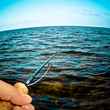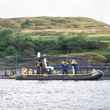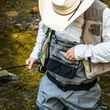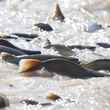I'm on a rock rise in the middle of one of 1,000 lakes. The breeze is at my back and I'm rolling footage on a canoe that's out of arm's reach, but within earshot. Steve Piragis and Reid Carron are in the canoe that's sliding across calm water. Piragis paddling, Carron casting. I'm pleased with what I see, but I'm concerned about what I'm hearing.
"Copper mines really can't prevent polluting the watershed around them," says Steve Piragis, Piragis Northwoods Company co-owner and canoe outfitter. "They all say they won't and they all pay the fine when they do."
Twin Metals Minnesota, owned by Antofagasta based in Chile, wants to open a copper mine near the Boundary Waters Canoe Area Wilderness. The site is outside the wilderness border, but at the top of the watershed in Superior National Forest. If something goes wrong, the acidic waste from mining copper could roll downstream into 1.1 million acres of federally protected woods and water.
"The proposed type of mining has never been done without some type of environmental impact," says Lukas Leaf, Sportsmen for Boundary Waters outreach coordinator. "This is the wrong place for that type of mining because of how sensitive and interconnected the Boundary Waters ecosystem is."
BWCAW garnered wilderness designation in 1964. Minnesota's mining history goes back much farther than that. Not the copper kind, the iron kind. The northern land is known for iron ore and miners are proud of what they exhume for the rest of the world to consume. Mining means opportunity in Minnesota, but Piragis sees his canoe outfitting business as a better opportunity. He's one of 23 outfitters operating out of Ely, the Boundary Waters' western gateway. He's invested in the kind of opportunity created by tourism and recreation.
"Our jobs are more important than mining jobs because they're sustainable into the future," Piragis says. "Mining employs some people, but it doesn't employ them very long. Mining is a boom and bust industry. Always has been. The resource goes away and there's a wasteland left behind."
Those fighting over the mine don't pretend to be friends. I witnessed a heated exchange between opposing sides during a panel discussion at the Outdoor Writers Association of America conference in Duluth a few days before I visited the Boundary Waters. It was like watching the rabid fight over wolves transplanted in Idaho a few decades ago. Attacks were unfiltered and unapologetic.

When Becky Rom, Save the Boundary Waters board vice-chair, rambled off a list of valid reasons for opposing a mine so close to the Boundary Waters, Chuck Novak, the mayor of Ely, Minnesota spit back with, "If that were a book at Barnes & Noble, it would be in the fiction section."
Novak wants the copper mining explored, but at this point, exploration isn't even an option. The U.S. Forest Service started a two-year hold in January while the impact of mining the resource is researched.
If Piragis and those opposing the mine get their way, the two-year hold will turn into 20. The Forest Service is accepting public comments until August 17 on whether a 20-year mining ban should be established for a 234,000-acre buffer around the Boundary Waters.































Comments
Daniel Hernesmaa replied on Permalink
This whole article is based on fear mongering with no science in this watershed to back it up. We are talking about low sulfate copper-nickel here not the high sulfates that other mines in different parts of the country have mined.
By Babbitt MN more than 50 million tons of sulfide copper-nickel bearing rock was removed in the 1970s to get at the taconite ore body. This was stored in stockpiles that covered 320 acres. In the 40 years it has been sitting, Birch Lake has not become polluted which is downstream of this stockpile. If this unprocessed sulfate ore stockpile didn’t cause harm to Birch Lake and other lakes downstream, including lakes in the BWCAW, how can a modern mine with new technology and the latest mitigation measures pollute the BWCAW?
There is a false claim that even the Quetico Provincial Park and Basswood Lake will suffer irreparable damage. To do that would require massive amounts of pollution in the Rainy River basin and would need to go upstream of the main flow to Hudson Bay to completely affect these; which would be impossible. You would need millions of times more sulfates and heavy metals then a mine(s) could ever produce.
Waste rock, although highly fractured, that would occur during any mining activity, is the same rock that occurs over much of the BWCAW. How come miles and miles of this naturally occurring sulfide rock hasn’t destroyed the wilderness and leached toxic sulfates and heavy metals? It’s been sitting there for millions of years as water washes over it into the waters of the BWCAW. They both contain low levels of sulfates and heavy metals. The waste rock will be mitigated, the bedrock in the BWCAW won’t.
I’m waiting for the EIS to do the science and you should be too. If a new mine in low sulfate ore is going to cause irreversible harm, I don’t want it either.
Mike Cole replied on Permalink
Copper nickel mining opponents continue their doom and gloom message. All those of us on the pro mining side are asking for is that they follow the established policies already in place. An EIS and Record of Decision is already in place for exploratory drilling in the Superior National Forest. If a mine is going to be built it would have to follow all NEPA regulations in place. If it doesn't make the grade there it doesn't happen. What happened to due process.
Pages